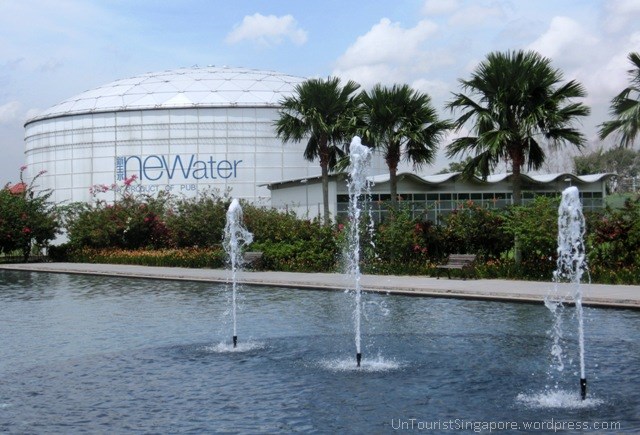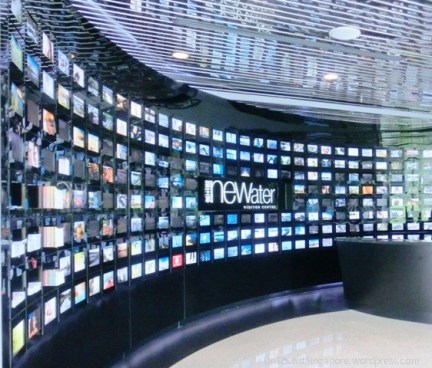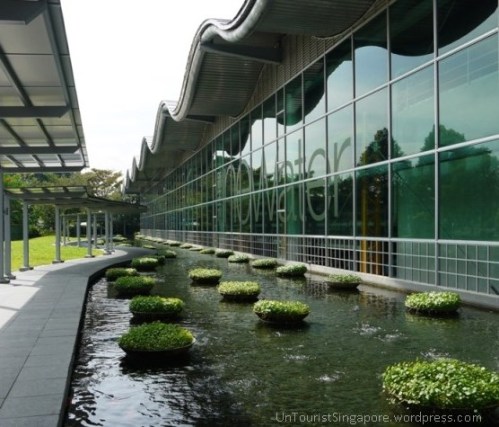Wastewater recycling is not a new concept, and sewage has been treated and reclaimed as water good enough for irrigation and other general uses for many decades.
What is novel however is the extraction of potable water from sewage. One might even think that some kind of sorcery is involved when sewage – yes including all that nasty stuff flushed down toilets – is magically conjured into crystal clear water safe for human consumption. This “toilet to tap” water purification, as the pundits have termed it, actually uses advanced membrane technologies, and Singapore is one of the pioneers in implementing potable water reclamation on such a grand scale.
NEWater, Singapore’s cleverly branded reclaimed sewage water using advanced water purification technologies was unveiled in 2003. The launch of NEWater marked the culmination of many years of research and development by Singapore’s national water agency, the PUB in its mission-critical effort to find water sources for the country. The recycling of used water seemed an obvious solution, never mind how repulsive the idea may seem.
The production of NEWater involves a 3-step water purification process. First, conventionally treated wastewater is put through a microfiltration process using membranes to filter out any solids, fine particles and bacteria. The second stage is a reverse osmosis process where high pressure is used to force tiny water molecules across the micro pores in a semi-permeable membrane, trapping the larger sized impurities on the other side. The final step, for good measure is to disinfect the water by zapping it with ultraviolet light killing any residual micro-organisms. A small amount of alkaline chemicals are then added to the water to restore its pH balance.
The result is water so clean that it is in fact deemed too clean to be drunk in large quantities. Stripped of all minerals, the ultra clean water would actually leach nutrients out of our bodies, just as it would leach minerals from the metal pipes it runs through. As such NEWater is used largely by wafer-fabrication and other industrial plants involving sensitive manufacturing processes. There the NEWater is further treated into higher grade ultra pure water (UPW) and used to clean the delicate microscopic semiconductors from which computer microchips are made (read an interesting article about this “dangerously clean water” used in the manufacture of technology products). A small percentage of NEWater is also added to the raw water in our reservoirs.
NEWater is not produced for direct consumption, although samples in small drinking bottles are available and given out for publicity and promotional purposes at national events such as Singapore’s national day parade. Ironically minerals and salts have to be added back to the NEWater to make it drinkable and more palatable.
THE LOWDOWN
So what has been the driving force behind Singapore’s unwavering search for water sources, that has prompted us to take such drastic measures as to reclaim our sewage? In a nutshell – politics, and a nation’s pride.
Singapore’s small size and inadequate water catchment facilities have forced us to long be reliant on neighbouring Malaysia for our fresh water supply. At the time when Singapore gained independence from Malaysia about 50 years ago, up to 80% of the country’s fresh water was imported from Malaysia. Thanks to our colonial government then the British had negotiated water agreements in 1961 and 1962 entitling Singapore to buy huge supplies of water from Malaysia, and for cheap.
Over the years, as Singapore prospered the water agreements became a point of contention for our Malaysian neighbours who argued that the old contracts at outdated prices needed to be re-negotiated. The agreements did indeed entitle Malaysia to review the prices after 25 years, however Malaysia neglected to do so at the 25 year marks for both contracts. By-the-book Singapore then artfully and successfully argued that the treaty allowed for prices to be renegotiated only at those points in 1986 and 1987 respectively, but no later. Touché, albeit on technicalities.
Still, Singapore has been all too aware of its unhealthy dependency on Malaysia for something as basic as water, and did not relish such a vulnerable position where the country is held ransom to the threat of a water supply cut every time the 2 neighbours had a disagreement. Water is the lifeblood of any community, and the Singapore authorities set about its quest for water self-sufficiency with a vengeance. Among other water resources such as desalination of sea water and the improvement of rainwater catchment, reclamation of wastewater became a key focus.
Today, Singapore’s 4 NEWater plants produce more than 115 million gallons per day (mgd) (430 million litres per day) of NEWater. By 2020, total capacity will be 197mgd when NEWater is projected to meet as much as 40% of the country’s water needs. By 2060,Singapore is expected to be 80% self-sufficient in our water needs, with 55% coming from NEWater. NEWater it seems, is indeed our liquid gold.
VISITING
A key component of the NEWater launch has been the communication and PR campaigns to build public awareness and acceptance of NEWater. While there were the usual wisecracks about “s**t water” when it was first introduced, the skepticism around NEWater has since died down, and NEWater is well, just water now.
The NEWater visitor centre opened in 2003 at the same time NEWater was launched, to educate the public about reclaimed water and Singapore’s water challenges. At 24,000 sq feet large the visitor centre is sizable and impressive. The centre was recently upgraded in June 2012 and now boasts state-of-the-art interactive panels, attractive and engaging multimedia information displays, as well as fun and games. Visitors are led through the centre on a guided tour which has been shortened to a more manageable 45 minutes instead of the hour and a half previously.
The tour starts off with a brief video about the “Waters of Singapore”. Next up is a multimedia area for guests to explore the displays and have fun with the games. All the exhibits promote hands-on learning and are kid-friendly, and when we were visiting in fact there was a preschool group touring the centre.
The tour will then take you through a mockup of a tunnel similar to the ones used in the Deep Tunnel Sewerage System (DTSS) where you will be briefed on this gargantuan project. If you have not heard about the DTSS as I suspect most people in Singapore haven’t, take some time to learn about the mind-boggling construction of a “used water superhighway” crisscrossing the island deep in the bowels of the earth, deeper than the MRT tunnels even. No wonder much of Singapore seems to be one large construction site at the moment with constant digging going on everywhere, what with works on the MRT and the deep tunnel sewage system happening simultaneously.
The last part of the tour takes you through a walkway overlooking the actual factory areas, and every step of the NEWater purification process is carefully explained. The tour ends outside of the facility where you can view the large NEWater storage tanks as well as admire the centre’s water features.
LOCATION
20 Koh Sek Lim Road off Upper Changi Road East (near the Singapore Expo Centre)
Open: 9am – 4pm when the last tour starts (Tues – Sun)
Free admission, however touring of the facility is by (free) guided tours only
Guided tour timings: 9am, 10.45am, 12.30pm, 2.15pm, 4pm
HOW MUCH TIME
The tour takes about 45 mins. Factor in another 15 mins or so to admire the centre’s grounds and to browse the open exhibit area in the basement.
TIDBITS
- Singapore’s 2 colonial era water agreements with Johor, Malaysia signed in 1961 and 1962 allowed us to purchase up to 136 million gallons per day (mgd) of fresh water at the paltry sum of 3 Malaysian sen per 1000 gallons. That’s less than US 1 cent per 1000 gallons. The treaty also specified that Singapore, with its water treatment capabilities, had to turn around and provide Johor a daily supply of treated water, however at a price of 50 sen per 1000 gallons – almost 16 times the cost of the raw water we purchased from Johor. The water treaties are widely acknowledged to be favourable to Singapore.
- There are currently 4 NEWater plants in Singapore – in Bedok, Kranji, Ulu Pandan and Changi (the Seletar plant closed in 2011). The newest plant at Changi opened in May 2010, and is also the largest, capable of producing 50 million gallons of NEWater a day.
- According to the PUB, Singapore currently uses about 400 million gallons of water a day, 45% consumed by home consumers. The total water demand is projected to double to 800 million gallons a day by 2060.
- Calcium is added to NEWater to prevent pipe damage.
- More countries and states have turned to reclaiming sewage water out of necessity, among them Egypt, Israel, Australia and the US. A number of these projects have met with public resistance however pointing to the importance of public education and PR efforts to mitigate the “yuck factor” when launching sewage water reclamation projects.
TAKE NOTE
- The tour and centre are wheelchair friendly.
- The tours are usually in English, however Mandarin Chinese tours can be arranged as well. Tours can only be booked online and in advance here.
USEFUL LINKS
- PUB’s NEWater site
- PUB’s NEWater Visitor Centre site
- Singapore Tourism Board’s page on the NEWater Visitor Centre
- National Library Board’s Infopedia site about the Singapore and Malaysia Water Agreements
- The Economist article from 2003 about the NEWater launch
- FastCompany article about the Bill and Melinda Gates Foundation’s efforts to reclaim solid waste as well











Very informative. How do you think little ones would cope with the tour and how much time do you get in the play area?
Hi, I think the little ones will manage a 45 min tour alright. The place is big and right with lots colour and water, kids love that. We had about 15 mins in the interactive/play area, but this depends on your group really. We only had 5 in our group on a weekday morning, including a 2 yr old, so got done pretty quickly.
Pingback: Marina Barrage: Alleviates or Worsens Singapore’s Flooding? | UnTourist Singapore
Just noticing the photo of the sign noting that “We use 152 litres of water per person per day”, or just over 40 US gallons. Where I grew up, it was not unusual for us to be on water rationing for several months each year, with rations set as low as 15 gallons per person per day. In all the years that I have been here, it never fails to shock and amaze me how much water we
usewaste when it is so obviously in critically short supply.Considering that this Government has long and famously been such a fan of PR campaigns aimed at our own people, I’m surprised that we don’t see regular water-conservation campaigns. Ask yourself: if, say, the water from Malaysia was cut off somehow and tight rationing was instituted until it came back on stream, could you live on 60 litres of water a day?
Hi Jeff,
15 gallons a person/day sounds impossible, however I bet people in the desert or other arid places get by on less.
Yes Singaporeans are spoilt. Actually when I was growing up in the 70s we did have water rationing (I think), or at least we had plenty of govt campaigns asking us to use less water! Agree we need to bring the campaigns back. The recent drought we had here in Feb was a good wake up call actually. Had it lasted any longer than the 2 months we would have had to start water rationing like Malaysia did, heaven forbid!
I wonder if that graphic with the the stat by PUB about the 152 litres a day is up to date, I’ll bet it’s actually higher now. In our utilities bill there’s a chart tracking our usage against the national averages for household types – and the water consumption figure seemed high for my house type. I am below the national average, however what I use works out to more than 152 litres a day! Hanging my head in shame now and making it a point to use less water. I didn’t even realise there’s a “Water Conservation Tax” slapped on to our water bill even!
Let’s not even look at the electricity consumption now..
Hi visitors to this site,
Please take note of the following updated information for the Newater Visitor Centre:
1. There are no longer shuttle services from Tanah Merah MRT Station. This has not been available for a long time since.
2. Bookings can only be made online and not through telephone.
For your information.
Hi Zahid,
Thanks for the update! I’ve verified this, and have also updated the info on my site.
Regards
MBev